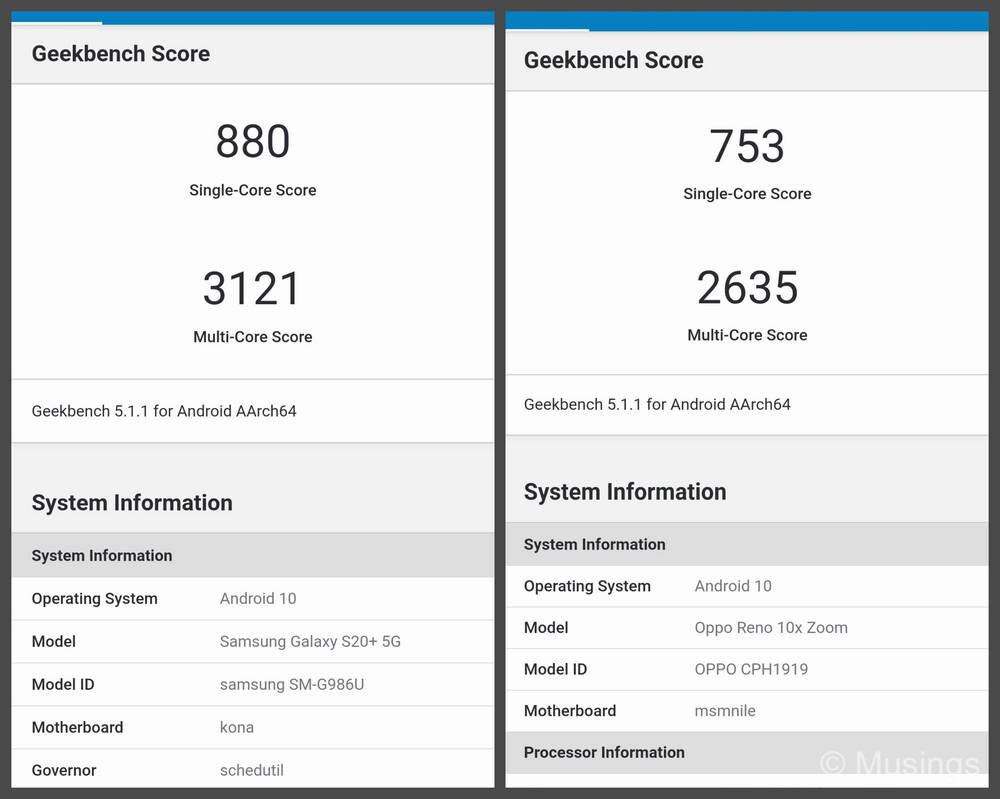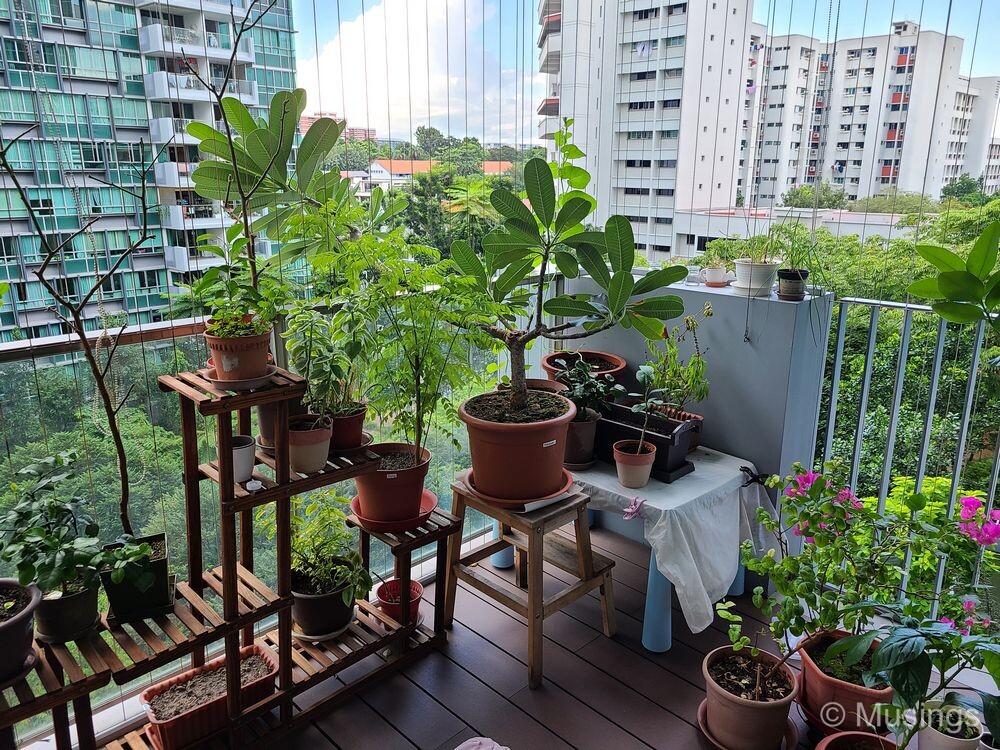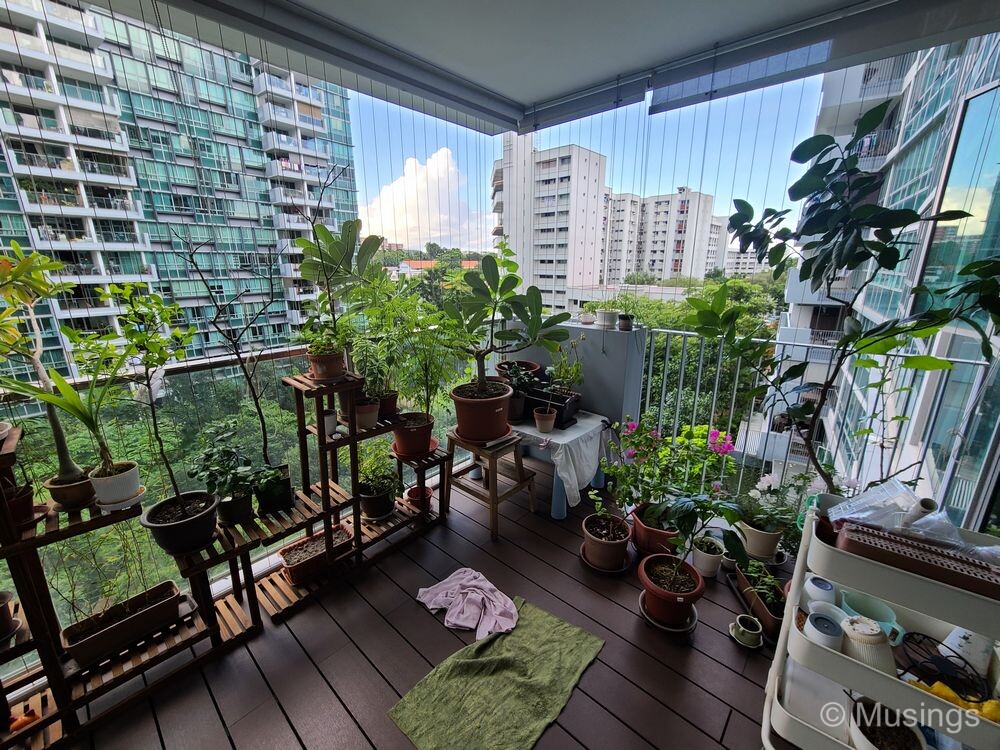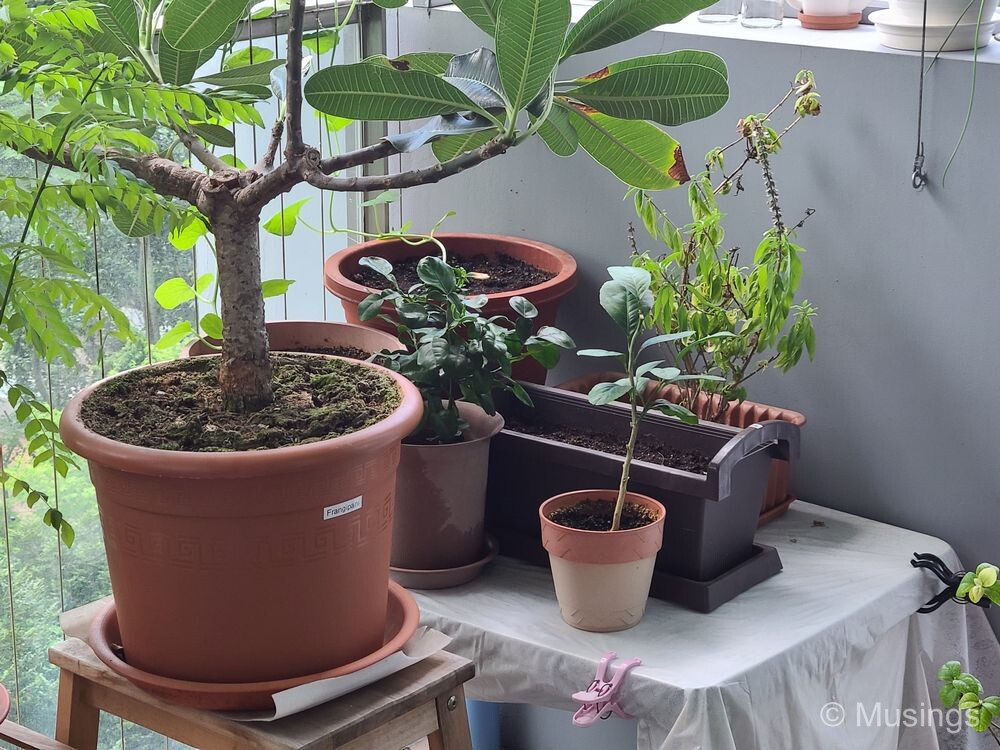Continued from the last post!
The Snapdragon 865 in the S20+ has a lot of processing power to spare for general use, such that enabling medium or high power saving modes still provides for a very responsive phone in general use cases. Truth to tell, I was a little worried initially whether I was getting a lemon – given how cheap the phone was compared even to the street price of the phone elsewhere. But a test on Geekbench settled it: the phone was clocking in a score of 880 and 3,121 on the single and multi-core benchmarks respectively. That’s actually even higher than the baseline for the phone, as seen on Geekbench’s own tabulation of 803 and 3,074 respectively. The Oppo Reno’s scores are also below:

As with phones that are issued with telcos, the S20+ also came preinstalled with a bunch of T-Mobile apps that I have no interest in. And that’s on top of the bloatware that Samsung also pre-installs on their phones too. Generally speaking, opinion seems divided among users whether it’s a good idea to remove bloatware through Android Debug Bridge (ADB) shell commands: firstly, they’re an eyesore, and secondly, they take up storage space. On the other hand, some users have also reported poorer battery life upon removal of selected pre-installed apps, as the phone might go on a internal processing loop trying to look for these apps. In my case, the launcher I routinely use on my Android phones – i.e. Nova Launcher – does a decent job of hiding any apps I don’t want to see from the app drawer. So, it’s less of an eyesore – unless I go about looking for them under Settings => App Management. There are several apps on Google Play that disable and not remove apps though, and even if all they’re doing is to automate a manual process, it’s still convenient as a one-touch solution.
Oddly, even though my copy is a T-Mobile variant, there is still some subtle hints of its origin – that it’s likely from a Hong Kong reseller. There are a few places albeit buried deep in settings where Chinese characters still show up. Thankfully they’re few and far in-between and thus don’t bother me too much.
The T-Mobile phone oddly so far seems very slightly behind in Samsung’s aggressive update schedule for their S20 phones. Specifically, the May security patch has been released around the start of this month, with the first users in Europe receiving the updates around then. But this variant only picked up the download 2 days ago from the time of this post.
Thanks I reckon also in large part that these S20 phones are widely distributed internationally, there’s a big community of users discussing all kinds of tweaks and tricks to improve various performance aspects of the phone. For instance, Samsung doesn’t provide a refresh rate setting between 60Hz and 120Hz: it’s one or the other. Moreover, enabling Medium Power Setting to lengthen how long the battery can run before expiring also disables the 120Hz refresh rate altogether. Undeterred, one enterprising user at XDA-Developers site wrote an side-loadable APK that enables a 96Hz display mode. And it actually works! Another enthusiast even posted a simple procedure that uses Bixby Routines to enable 120Hz even while on Medium Power setting: and this procedure sits entirely within the phone too i.e. no need to sideload or enable developer debugging. Unlike some other phones, Samsung doesn’t provide much customisation tweaks to their power profiles though. So for instance, I can’t have a profile that enables 100% CPU performance but disables selected background services. Maybe there’s an app for that? LOL.
The other nifty thing about these widely distributed phones are the accessories. Amazon Singapore – with their next 48 hrs delivery – carries a number of Spigen-brand cases for the S20 phones, and routinely lists them for much cheaper than if you bought from the official Spigen resellers at Lazada or Qoo10. I’ve picked up several such cases from Amazon SG. I also easily found customized underwater casings for my old Samsung S8+ phone previously for instance – something I couldn’t easily find for the Oppo Reno as it saw relatively limited distribution around the world. Similar cases exist for the S20+ on Amazon. So once the Circuit Breaker measures end and when I can hit the swimming pools again, I’ll be looking into purchasing one such case for this S20+.
The S20+ was able to work with almost all apps I threw at it. Well, excepting this so far: Microsoft’s Your Phone Companion – an app that ties the phone to your Microsoft account, and permitting a linked PC to control selected media-related parts of it. Thankfully, these limitations didn’t affect me much: I’m already quite heavily tired in with Google’s cloud services – including messaging, Photos and Google pay, so not having the Phone Companion was livable.
And finally, the S20+ camera module. Well, it’s a Samsung alright: their Galaxy line of phones are well-known for putting out pictures that are contrast-y and saturated. It’s basically a matter of personal preference whether one likes photos out of the box to look this punchy, since no – it’s not like the actual scene actually looks quite so colorful normally. Then again, I finally get RAW support again – hooray, as the Oppo Reno had no such – and the S20+ even supports the new and very efficient HEIF codec. Oddly, the image browser software I use on all my Windows laptops – FastStone Image Viewer – isn’t able to display EXIF information for pictures taken using in HEIF, even though the EXIF meta data is right there under file properties. Something I’ll need to check on further. More importantly, the S20+’s records 4K video that is better stabilized than the Oppo Reno; something I wasn’t particularly impressed with on the older phone. Both the S20+ and Oppo Reno still suffer from video jitter when I do quick pans from left to right, but at least the recorded video suffers is better stabilised when I’m recording and walking. Both phones support the H.265 codec, and the 4K 30fps on the S20+ clocks in at 29,411kbps video + audio bit rates.
Some casual pictures at the balcony:



In all, I’m pretty happy with this new Samsung S20+ 5G. The big benefits in this phone for me are its 120Hz refresh rate, great screen-to-body ratio at ~90%, RAW support for photos, decent video stabilization, wireless-charging and the IP68 rating. Not particularly novel features aside from the 120Hz refresh rate, but I gave up many of these features during the period I had the Oppo Reno 10x zoom. On the flip-side, the S20+ doesn’t offer a true full-screen display with its punch-hole camera, has so-so only battery life, phone-unlocking is a little lethargic, and that the phone is fairly expensive though – though in all fairness, all the 2020 flagships from mainstream manufacturers have been listed at higher prices.
I’ll do an update to this phone later this year on how it fares after a long period of use!
Hi Chek Yang, enjoy reading your blog on Minton, I have some questions on the place and was wondering if you can help me with it? Thank you in advance.
Hey there; of course I’d be happy to help. I’ll email you later.
My apologies, I completely missed your email! I have just replied your email.
Hi Chek Yang,
Saw a post that you had placed washer and dryer in the yard toilet.
May I know so far how is it?
Just bought a new condo and was thinking to do the same due to the space constraint.
Hope to hear from you soon.
Thanks.
Hi there,
Thanks for the visitation to our blog. The post you might have read about is likely this one:
https://www.chekyang.com/musings/2014/04/17/the-minton-ideas-and-renovation-45-the-yard-the-washer-the-door/
The apparatus has actually worked remarkably well all these years of our use, and is actually the second time we’ve done this (the first was at our first condo before moving to Minton in 2014). It really does save space to stack one on top of the other.
The only caveat though is that the washer might need to had been designed with that in mind. I can’t speak for all washers, but that Electrolux had washers that supported this feature was why we went with one such front loader.